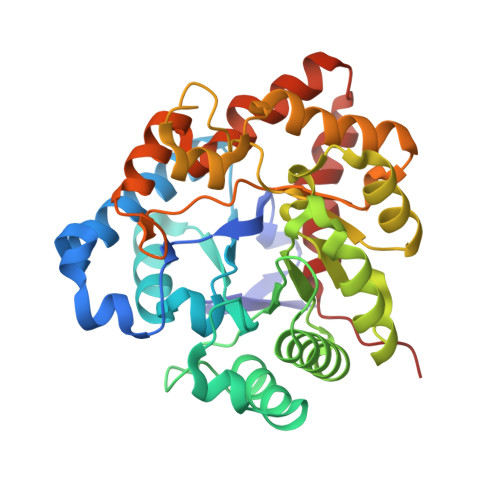High resolution X-ray structures of different metal-substituted forms of phosphotriesterase from Pseudomonas diminuta.
Benning, M.M., Shim, H., Raushel, F.M., Holden, H.M.(2001) Biochemistry 40: 2712-2722
- PubMed: 11258882
- DOI: https://doi.org/10.1021/bi002661e
- Primary Citation of Related Structures:
1HZY, 1I0B, 1I0D, 1JGM - PubMed Abstract:
Phosphotriesterase, isolated from the soil-dwelling bacterium Pseudomonas diminuta, catalyzes the detoxification of organophosphate-based insecticides and chemical warfare agents. The enzyme has attracted significant research attention in light of its possible employment as a bioremediation tool. As naturally isolated, the enzyme is dimeric. Each subunit contains a binuclear zinc center that is situated at the C-terminal portion of a "TIM" barrel motif. The two zincs are separated by approximately 3.4 A and coordinated to the protein via the side chains of His 55, His 57, His 201, His 230, Asp 301, and a carboxylated Lys 169. Both Lys 169 and a water molecule (or hydroxide ion) serve to bridge the two zinc ions together. Interestingly, these metals can be replaced with cadmium or manganese ions without loss of enzymatic activity. Here we describe the three-dimensional structures of the Zn(2+)/Zn(2+)-, Zn(2+)/Cd(2+)-, Cd(2+)/Cd(2+)-, and Mn(2+)/Mn(2+)-substituted forms of phosphotriesterase determined and refined to a nominal resolution of 1.3 A. In each case, the more buried metal ion, referred to as the alpha-metal, is surrounded by ligands in a trigonal bipyramidal ligation sphere. For the more solvent-exposed or beta-metal ion, however, the observed coordination spheres are either octahedral (in the Cd(2+)/Cd(2+)-, Mn(2+)/Mn(2+)-, and the mixed Zn(2+)/Cd(2+)-species) or trigonal bipyramidal (in the Zn(2+)/Zn(2+)-protein). By measuring the anomalous X-ray data from crystals of the Zn(2+)/Cd(2+)-species, it has been possible to determine that the alpha-metal ion is zinc and the beta-site is occupied by cadmium.
Organizational Affiliation:
Department of Biochemistry, University of Wisconsin, Madison, Wisconsin 53706, USA.



















